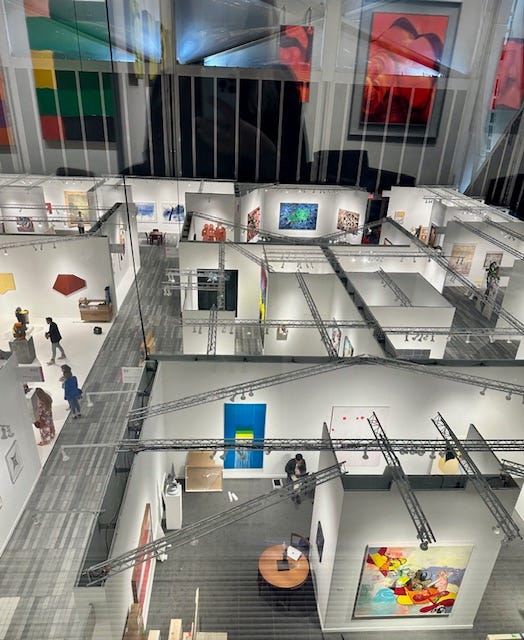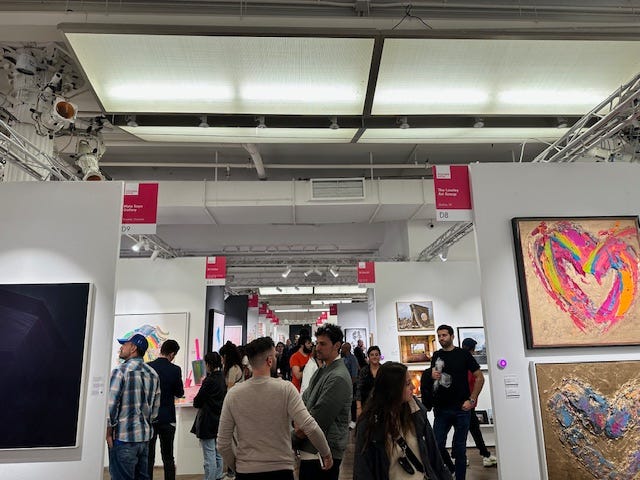How much is that painting?
Art buyers, weirdly enough, like to know how much artworks cost when they're considering different purchases, but that information can be hard to come by.
A quick note before we get into the next installment of Priceless: this newsletter is free, so if you’d like to make a small donation to support my work, I’d be very grateful, and you can do so by going to buymeacoffee.com. Thank you!
Greetings! There’s been a lot going on in the art market, and indeed the whole world, since the last quarterly installment of this newsletter. How is it that three months, rather than three years, have elapsed since February?
In this newsletter, I want to talk about three art market reports that have been published over the last couple of months. The art world is a murky universe, so when you get new data, you jump on it. The first is Artsy’s April Art Market Trends Report, which surveyed 1,600 galleries and collectors around the world about price transparency in the art market, among other things.
As I’ve written before, the art market is a particularly opaque when it comes to prices, which can make figuring out what you should pay for art challenging. The only publicly available sales data for individual transactions in the art market comes from sales of art at auction. Galleries and dealers, where around 60% of sales happen, don’t reveal how much artworks sell for, and a lot of the time, don’t display the price of the art they have for sale either.
Galleries are notoriously bad about displaying prices in their physical locations, but apparently that applies online too. Only 44% of the galleries surveyed in Artsy’s report said that they display prices for all artworks sold online, while 25% said they only share prices on request.
Collectors are understandably pretty fed up about this. It’s harder to assess one potential purchase against another if you have request prices first, just as it’s harder to figure out what to pay for art when so much price information in the art market is missing. Some 60% of collectors surveyed said that price transparency in the art market should be improved, and even though 62% of galleries acknowledged that transparency was very important to collectors, only 21% took steps to improve that in 2024.
One reason why more galleries haven’t addressed this is that many consider how they determine the price of art to be proprietary information, and want to keep that under wraps. There’s a reason why you see ‘price on request’ notices in galleries so frequently.
Source: Artsy’s Art Market Trends 2025 report
The good news is that some organizations are developing new AI-enabled art market intelligence tools, using the art market data that is available, to help buyers figure out what they should pay for art. In March, Web3 art platform LiveArt launched LiveArt AI Agent, a tool that combines public data with the company’s own sales information and is trained on public auction records, private sales, digital assets and blockchain transactions. Buyers can use it to get insights on pricing across a range of categories, from Old Masters to digital assets.
Art market data and analytics company Artnet is also working on a new AI-powered tool, to be released by the end of this quarter. According to the press release, the tool, trained on the public auction records in Artnet’s database, will help art buyers with art valuation by providing instant market analysis, historical context, price comparisons, and pricing trend forecasts.
It will be really interesting to see how useful art buyers find these new tools, but as with all AI applications, their usefulness is only as good as the data behind them, and there’s a lot of data missing when it comes to the art market.
The simplest way to improve price transparency in the art market would be for more galleries to display the price of the art they have for sale. That’s certainly what the collectors surveyed by Artsy want, and what galleries should do if they want to attract new art buyers, but whether they will remains to be seen.
Demand for affordable art is up
Two other reports that surveyed the art market’s performance in 2024 revealed another interesting finding – and provided a nugget of good news for the art market, which contracted in 2024 for the second year running. Although the total value of art sales at auction dropped significantly last year, driven by a sharp decline in multi-million-dollar art sales, sales of artworks under $5,000 were up.
Artprice’s 2024 Comtemporary Art Market report, published in March, found that 108,000 lots of contemporary art priced under $5,000 sold at auction between July 2023 and June 2024, up 6% over the previous 12-month period. Similarly, the Art Basel and UBS Art Market report found that while overall art market sales fell 12% in 2024, the value of artworks sold at auction under $5,000 increased 7% and the volume of art sales at that price increased by 13%.
Although this segment has always generated the highest volume of auction market transactions by far, that’s a big increase. “There were actually thousands more transactions happening at auction last year than in the previous year, but they were all under $5,000, which is really interesting,” Dr. Clare McAndrew, the report’s author, said at a press conference for its launch. Away from the auction market, 61% of collectors surveyed in Artsy’s report said they were also looking for artworks priced under $5,000.
Source: 2024 Art Basel and UBS Art Market Report
In an article last month in The Art Newspaper, Scott Reyburn wrote about the new buyers that are helping to drive sales of more affordable art, particularly through online platforms. He also looked at whether the slump in sales of the most expensive, so-called blue chip art, and the growth in sales of lower priced works, meant that interest in art as an investment is waning.
There’s some evidence to support that in the slowdown in multi-million-dollar sales. The speculators that were flipping new works by ultra-contemporary artists at auction for millions of dollars in 2022 are out of the market now as prices in that segment have cooled dramatically. Indeed, the value of auction sales of all contemporary art fell 36% last year to $1.4 billion, according to the Art Basel and UBS report, the lowest level in six years.
Art collectors have also been reducing their exposure by making less expensive art purchases over the last two years, given the general economic uncertainty and persistently high interest rates. Certainly, some important lots offered during the marquee auction sales in New York this week, including a bronze bust by Alberto Giacometti, estimated to fetch $70 million, have failed to find buyers.
But that doesn’t mean that people buying art for $5,000 or less are not considering its investment potential. In the current environment, art buyers are looking for more value and the chance to own the work of a wider variety of artists.
Plenty of art at this price won’t appreciate, but it obviously depends what you buy. As I wrote in the last newsletter, for example, editioned prints by blue-chip artists like David Hockney, where prices start at a few thousand dollars, have a very good chance of appreciating if you are prepared to hang onto them for long enough.
Although original art by emerging artists is also popular, it seems that lots of people are buying prints and other works in editions by well-known contemporary artists at this price point. According to Artprice’s report, the sale of art for under $5,000 at auction “has been largely supported by the multiples produced by emblematic figures of Contemporary art like as Takashi Murakami, Damien Hirst and Jeff Koons, as well as by world-renowned street artists like Keith Haring, Banksy, Mr. Brainwash, KAWS, Shepard Fairey and Invader.”
Source: Artprice’s 2024 Contemporary Art Market Report
Could it be that people are buying more affordable art for many different reasons – because they love it, because they value it, and because it just might make them money? An increased volume of art sales at an accessible price, supported by a wider range of buyers, seems like a very good thing for the art market and for art collectors. Let’s hope it continues.
I’ll leave you with some other news highlights below. Until next time, thanks for reading!
News in brief
The 1997 painting Miss January by Marlene Dumas set a price record for a living woman artist at auction this week when it sold for $13.6 million, including fees, at Christie’s in New York. That’s still a fraction of the auction record for a living male artist, set by Jeff Koons’s Rabbit, which sold for $91 million in 2019. I wrote more about the price discrepancy between men and women artists in the auction market here.
Although original artworks are so far exempt from the tariffs levied by the Trump administration this year (but not furniture, design objects, antiques and antiquities), moving art across international borders is already becoming more of a headache. Art Basel hosted an online discussion about the potential deglobalization of the art market in April, and an edited version of that conversation is here.
The second Zero Art Fair is taking place this July at The FLAG Art Foundation in New York City. The fair, which I wrote about last year, allows collectors to take home exhibited artworks for free, as long as they sign ‘store-to-own’ contracts with the artist.







